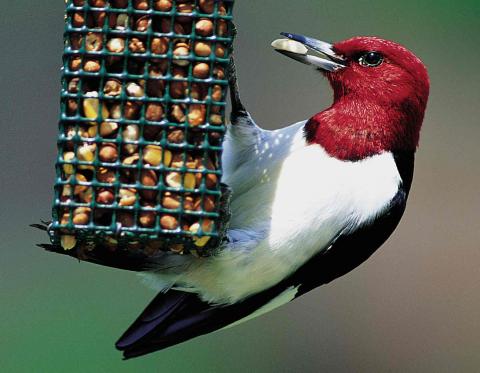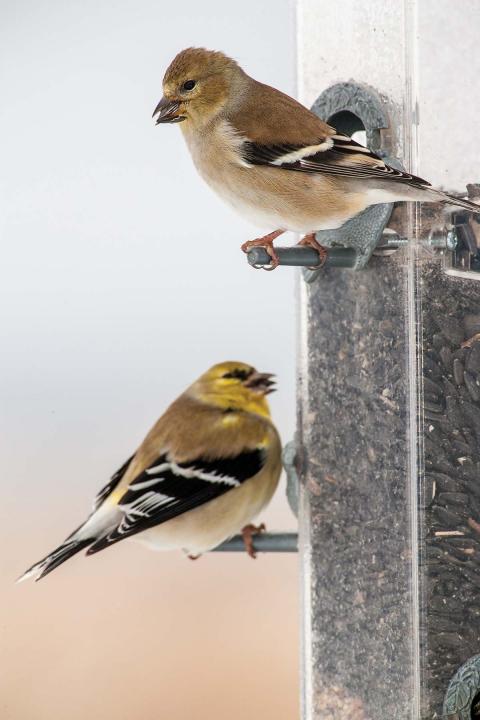Registration period:
April 23 - May 7
Date:
Tuesday, May 7, 2024 1:00 pm - Tuesday, May 7, 2024 2:00 pm
Location:
Powder Valley Conservation Nature Center
Birding is a fun hobby, but it can be hard to know where to start. Join a naturalist and learn about how to break in to this daunting yet rewarding activity. Hear about how to pick up this important hobby, then participate in a short hike on Tanglevine Trail where you’ll practice your bird identification skills. Meet at the frog statue in front of the nature center. Wear good walking shoes, dress for the weather, and make sure to bring plenty of bug spray, sunscreen, and water. The short hike will be approximately 1/3 mile.
Registration period:
May 1 - May 10
Date:
Friday, May 10, 2024 8:00 am - Friday, May 10, 2024 10:00 am
Location:
Runge Conservation Nature Center
Join MDC naturalists and area birders as we discover the avian life that calls Runge home. These short birding walks are for all experience levels. We will gather near the front doors of the nature center. Binoculars and field guides will be provided for those that need them. Registration preferred. Ages 8+
Registration period:
March 29 - May 10
Date:
Friday, May 10, 2024 11:30 am - Friday, May 10, 2024 12:30 pm
Location:
Online only
Join us during your lunchtime for a virtual program on birds!
From heroic acts to being messengers, and symbols from good and bad, birds are important characters in legends, folklore, and mythology. Celebrate Migratory Bird Day by discovering the beauty and glory of birds in Missouri. Learn how their histories, personalities, and their influence has impacted how they are perceived and seen by mankind.
An email will be sent with the link a day before the program by noon. If you register after that time, another link will be sent the morning of the program to ensure everyone has the correct link to join.
Registration period:
April 1 - May 10
Date:
Saturday, May 11, 2024 8:00 am - Saturday, May 11, 2024 10:00 am
Location:
Shoal Creek Conservation Education Center
Enjoy coffee and learning about birds? Join us at Shoal Creek Conservation Center for Birds and Brews! This partnership program gives anyone (14 years old and older) an opportunity to enjoy some bird friendly coffee and explore the world of spring bird migration through a short walk by Shoal Creek. The easy rated walk will be about a 1 mile long on some uneven trail surfaces. Bring your binoculars or a pair can be provided during the program. Registration is required. This event is hosted by the Missouri Department of Conservation, Ozark Gateway Audubon Chapter, and Wildcat Glades Nature Group.
Registration period:
March 6 - May 10
Date:
Saturday, May 11, 2024 9:00 am - Saturday, May 11, 2024 11:30 am
Location:
Cape Girardeau Nature Center
An early stage social engagement session for persons with early stage dementia and their care partner. Did you know that getting outdoors, interacting with nature, and learning new skills have shown to have positive benefits for individuals living with Alzheimer's and other forms of dementia? Join us at 9 a.m. Saturday, May 11, 2024 to learn the basics of birding. This session will include tips for using binoculars, ways to identify bird songs and how to use a field guide. This slow-paced, gentle walk will be held on the Farkleberry Knob Trail, a quarter-mile paved trail at the Cape Girardeau Conservation Nature Center in North County Park. We will also discuss how being outdoors can benefit those living with dementia and their caregivers. You may bring your own binoculars, or a pair will be provided for you.
This is a cooperative program with the Greater Missouri Chapter of the Alzheimer's Association.
Date:
Saturday, May 11, 2024 10:00 am - Saturday, May 11, 2024 11:30 am
Location:
Anita B. Gorman Conservation Discovery Center
No registration required (ages 13+) In the United States, window collisions are estimated to cause 600 million bird deaths annually and almost half of these are at home windows. Do you have a window or two at your home or office that is frequently struck by birds? Join MDC and the Missouri River Bird Observatory to learn why window collisions happen, the best strategies to prevent them and what actions are being taken to reduce window strikes around the KC metro area. It's simple and inexpensive to save birds around your home and office! If accommodations are needed, please e-mail the instructor at least one week prior to the program.
Registration period:
April 2 - May 15
Date:
Wednesday, May 15, 2024 10:00 am - Wednesday, May 15, 2024 12:00 pm
Location:
Twin Pines Conservation Education Center
Brown-headed nuthatches require a healthy, stable pine-woodland habitat — something Missouri had mostly lost but has been gradually regaining. Now that our state has restored some of its pine woodlands, approximately 100 birds were reintroduced in the Mark Twain National Forest between 2020 and 2021, and survival monitoring of the brown-headed nuthatches continues to present day. If this species is deemed a successful reintroduction, it will be considered a permanent resident of Missouri as it is nonmigratory. Join us as we discuss these intriguing birds while you paint your own water-color picture of the brown-headed nuthatch.
Registration period:
May 1 - May 16
Date:
Thursday, May 16, 2024 8:00 am - Thursday, May 16, 2024 10:00 am
Location:
Runge Conservation Nature Center
Join MDC naturalists and area birders as we discover the avian life that calls Runge home. These short birding walks are for all experience levels. We will gather near the front doors of the nature center. Binoculars and field guides will be provided for those that need them. Registration preferred. Ages 8+
Date:
Saturday, May 18, 2024 8:00 am - Saturday, May 18, 2024 11:00 am
Location:
Rockwoods Reservation
Join us for breakfast while enjoying the birds and blooms of Rockwoods Reservation! Come and take a stroll through the newly renovated native wildflower gardens around the Visitor Center while enjoying a doughnut and a cup of shade-grown, bird-friendly coffee! Naturalists will be available to share information about the flowers and how you can grow them in your yards or container gardens. Also, spring is an excellent time to see and hear the wonderful birds of Rockwoods! Learn how to identify those birds using the Merlin bird identification app. Naturalists will also be sharing tips on what you can do to protect birds and help them thrive, including that coffee that you will be enjoying! All are welcome to stop by for a few minutes or spend some time relaxing with us enjoying the sights and sounds of spring!
Meet at the Visitor Center.
All are welcome! No reservations are required.
Registration period:
April 11 - May 17
Date:
Saturday, May 18, 2024 8:00 am - Saturday, May 18, 2024 12:00 pm
Location:
Burr Oak Woods Conservation Nature Center
It is finally springtime, and the birds are out and about finding food plus we are in the heart of spring migration. Join us, along with some Burroughs Audobon experts on a hike to see the birds in action. We will meet at the front door to the nature center. We will then proceed to the trail for a hike to bird. We will keep our eyes out for spring wildflowers as well. Beginners and all experience levels welcome. Dress for the weather & bring your own binoculars, snacks, and drinks. Folks can leave anytime, if they have had enough.
Registration period:
April 10 - May 18
Date:
Saturday, May 18, 2024 8:30 am - Saturday, May 18, 2024 10:30 am
Location:
Springfield Conservation Nature Center
Learn some birding basics, including how to use binoculars properly, and get some identification tips. We'll start with a short presentation in the classroom and then hit the trails to look for birds.
Date:
Tuesday, May 21, 2024 6:30 pm - Tuesday, May 21, 2024 7:30 pm
Location:
Online only
Registration required by visiting https://www.mymcpl.org/events/93085/hummingbirds-101-zoom (all ages) The ruby-throated hummingbird is one of Missouri's most intriguing birds! Would you like to learn about these unique birds and how to attract them to your yard or garden? Join us as we learn about the native plants, sweet nectar and insects loved by this tiny creature, also known as nature's helicopter! This program is hosted by Mid Continent Library.
Registration period:
May 1 - May 22
Date:
Wednesday, May 22, 2024 8:00 am - Wednesday, May 22, 2024 10:00 am
Location:
Runge Conservation Nature Center
Join MDC naturalists and area birders as we discover the avian life that calls Runge home. These short birding walks are for all experience levels. We will gather near the front doors of the nature center. Binoculars and field guides will be provided for those that need them. Registration preferred. Ages 8+
Registration period:
May 1 - May 29
Date:
Wednesday, May 29, 2024 8:30 am - Wednesday, May 29, 2024 12:00 pm
Location:
Runge Conservation Nature Center
Do you love biking… and birding? Then this program is for you. Join us as we go for a leisurely ride to look for birds on Mokane Road in Callaway County, just north of Jefferson City. Mokane Road is one of the top birding hotspots in Central Missouri. This program is for birders of all experience levels. We will meet at Carl R Noren Access before carpooling to our starting point. Binoculars, bikes, and helmets will be provided for all that need them. Make sure to bring a water bottle. Participants under the age of 18 attending the program without an adult (18+) will need a signed permission form to take part in the program. Registration required. Ages 15+
Date:
Friday, June 21, 2024 9:00 am - Friday, June 21, 2024 11:00 am
Location:
Springfield Conservation Nature Center
Volunteer Naturalist Myra Scroggs will help you find some common nesting birds during this indoor and outdoor program. Ages 7 to adult.
Registration period:
April 24 - June 25
Date:
Tuesday, June 25, 2024 8:30 am - Tuesday, June 25, 2024 10:30 am
Location:
Springfield Conservation Nature Center
Learn some identification tips and birding basics, including how to properly use binoculars. We’ll start with a short presentation in the classroom and then hit the trails to look for birds. Ages 7 to adult.
Date:
Friday, August 2, 2024 6:30 pm - Friday, August 2, 2024 7:30 pm
Location:
Cape Girardeau Nature Center
Join photographer Paul Moffett in exploring the birds of the confluence. After retirement Paul started work on documenting, via photography, the birds of the confluence area. He's documented over 300 specimens in that 20 mile stretch between the Mississippi and Illinois Rivers confluence and the Mississippi and Missouri Rivers confluence. He volunteers for Audubon at Riverlands primarily working with the Swan Society and Missouri Department of Conservation.
This program is part of our Nature Center @ Night series, the building will remain open until 7:30pm.























